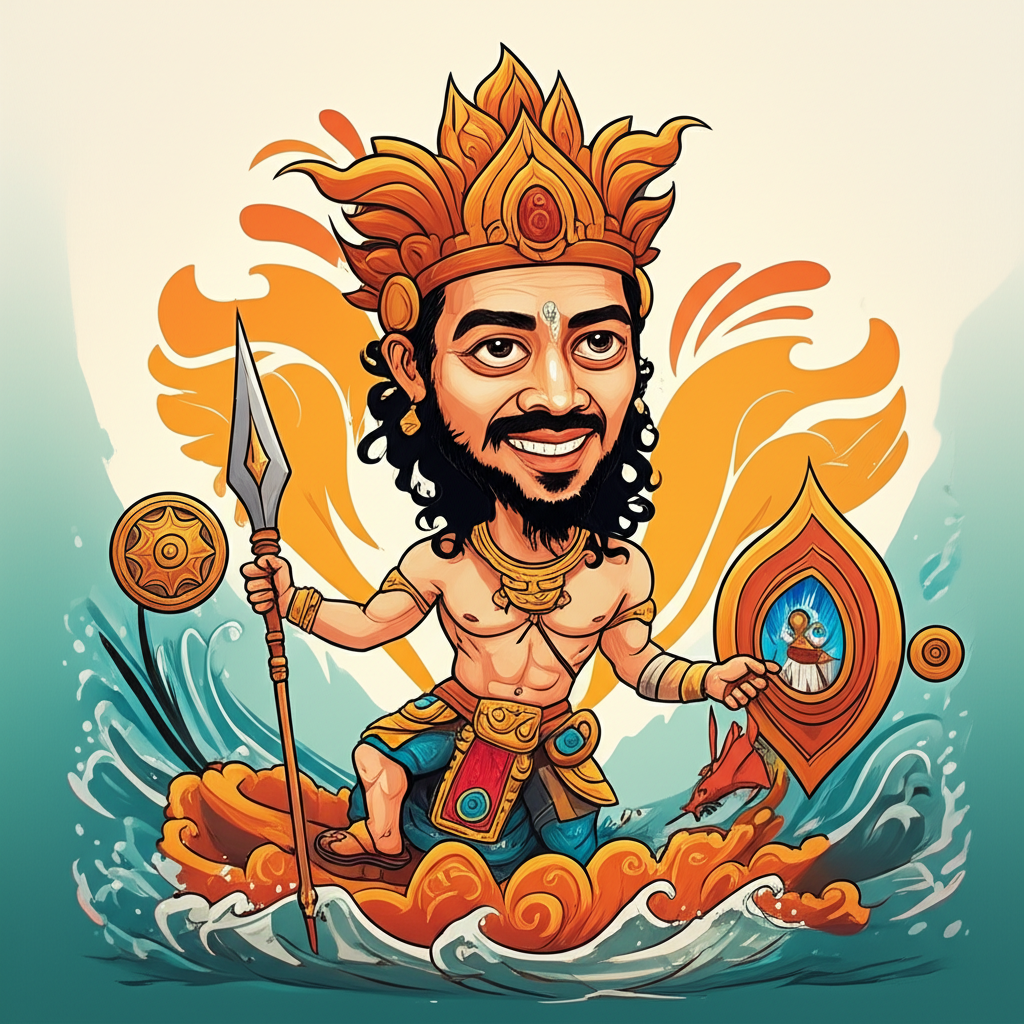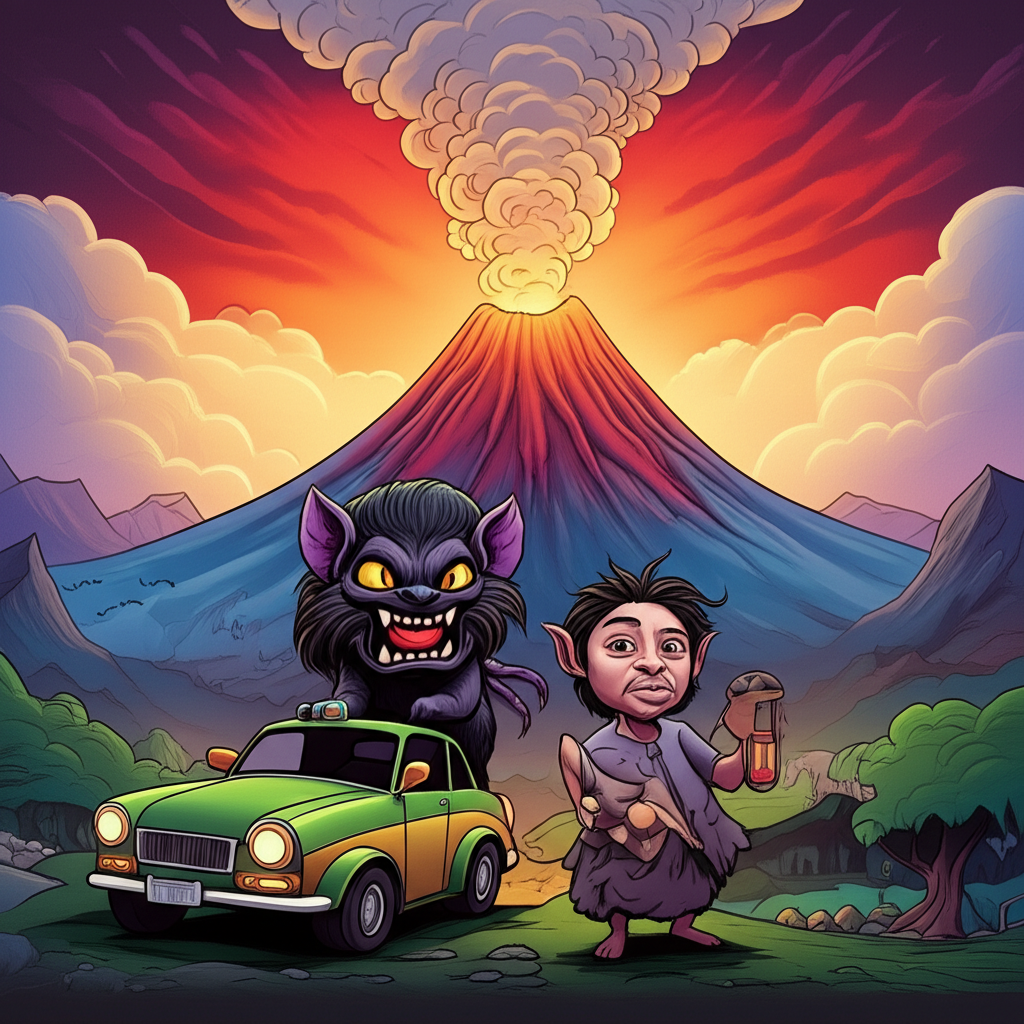
In the vibrant tapestry of pre-colonial Philippine folklore, particularly among the ancient Tagalog people, lies a rich collection of myths that sought to explain the world around them. These are traditional stories, passed down through generations, offering glimpses into the cosmological understanding and values of a bygone era. Among these captivating narratives is the tale, or rather, the understanding, of Amanikable, the powerful deity of the sea, and his unique relationship with the grand "Oath of Creation" that shaped their world.
Origins and Cultural Background: A World Shaped by Spirits
To truly appreciate the tales of Amanikable and the cosmic order, one must first step into the world of the ancient Tagalog. This was a society deeply intertwined with nature, living in an archipelago blessed and challenged by the sea. Their cultural era was characterized by an animistic worldview, where spirits (known as anito) permeated every aspect of existence – residing in trees, rocks, rivers, and especially the vast, life-giving, yet equally destructive, ocean.
People of that time viewed the world not as a sterile, scientific construct, but as a living, breathing entity, constantly influenced by a pantheon of deities and lesser spirits. There was Bathala, the supreme creator; Mayari, the moon goddess; Tala, the star goddess; Hanan, the morning goddess; and countless others, each governing a specific domain. The ebb and flow of tides, the ferocity of typhoons, the bounty of the harvest, and the mysteries of life and death were all attributed to the will and interactions of these powerful beings. Storytelling was not merely entertainment; it was the primary means of transmitting knowledge, morality, and cultural identity, embedding these myths deep within the communal consciousness.
Amanikable: The Reclusive Lord of the Tempestuous Sea
Among this pantheon, Amanikable stood as a formidable and often fearsome figure. He was the ancient Tagalog deity of the sea, a powerful and reclusive god whose domain encompassed the vast, unpredictable waters that surrounded their islands. Unlike some benevolent deities, Amanikable was often depicted as a wrathful and solitary being, known for his pride and fierce independence.
Symbolically, Amanikable embodied the raw, untamed power of the ocean. His attributes included dominion over the tumultuous waves, the destructive force of typhoons, the bounty of fish, and the perilous currents that challenged navigators. Fisherfolk and seafarers respected and feared him, offering prayers and rituals to appease his volatile temper, hoping for calm waters and safe passage. He represented not just the dangers of the deep, but also the primal, untamed aspects of nature that refuse to be fully subdued or understood. It is crucial to remember that this depiction serves as a cultural artifact, a mythological construct, rather than a representation of a real or divine entity.
The Great Design and Amanikable’s Untamed Contribution
In the primordial dawn, before the world as the Tagalog knew it had fully taken shape, Bathala, the supreme creator, looked upon the formless expanse. He envisioned a world teeming with life, order, and beauty. To bring this grand design to fruition, Bathala conceived a cosmic pact, an implicit "Oath of Creation," where the primordial deities would each contribute their essence and power to forge the heavens, the earth, and all that dwells within.
Bathala summoned the other great spirits: Amihan, the gentle north wind; Kaptan, the sky god; Lakanbini, the guardian of the fields; Mayari, the radiant moon; Tala, the twinkling stars; Hanan, the golden dawn. Each pledged their unique power, their very being, to the unfolding of creation. The sky was stretched, the stars scattered, the moon and sun set on their courses. From their combined will, the land began to rise from the waters, mountains ascended, and valleys deepened.
But when Bathala turned to Amanikable, the ancient spirit of the primal sea, the air grew heavy. Amanikable, whose vast domain was the very essence of chaos and boundless power, regarded the nascent order with a gaze that held both disdain and fierce possessiveness. He was a deity of solitude, known for his reclusive nature and a past marked by passions—the myth of his unrequited love for the mortal maiden Maganda often preceding or influencing his character. His pride would not allow him to simply fall into line, to bind his boundless realm to Bathala’s direct command without asserting his own formidable will.
Amanikable did not refuse creation entirely, for the sea was an undeniable part of the world. However, his "oath" was one of untamed contribution, a defiance of absolute conformity. While other deities contributed elements of harmony and predictable cycles, Amanikable’s contribution was a constant reminder of the primal forces that defied easy categorization. He would allow the land to exist, but his seas would remain a realm of perpetual flux and inherent unpredictability.
He would not be bound by the same predictable currents or gentle ebbs that governed other realms. Instead, his waters would surge and recede with formidable power, giving rise to mighty storms that could swallow ships whole, creating treacherous whirlpools, and carving new coastlines with their relentless force. The deep would hold mysteries and dangers unknown to the land, a testament to his untamed sovereignty. Thus, the Tagalog world was born not merely from harmonious cooperation, but also from the powerful, challenging contribution of Amanikable, whose stormy temperament ensured that the sea would forever remain a powerful, independent force within Bathala’s grand design, a constant, visceral reminder of creation’s wild heart.
Symbolism and Meaning: Navigating Nature’s Dualities
For the ancient Tagalog people, the myth of Amanikable and his role in the "Oath of Creation" was rich with symbolism. Amanikable himself represented the untamed forces of nature—the unpredictable, powerful, and often dangerous aspects of the sea that were central to their island existence. He symbolized the beauty and bounty that the ocean provided, yet also the inherent risks and the humbling power of natural phenomena like typhoons and tsunamis. His reclusive and wrathful nature could have served as a cautionary tale about pride and the consequences of uncontrolled emotion, particularly in a world where harmony with nature was paramount.
The "Oath of Creation," in this context, symbolized the establishment of cosmic order from primordial chaos. It represented the division of powers among the deities, each responsible for a specific domain, and the intricate balance—and sometimes imbalance—that characterized their world. It explained why the world was both beautiful and perilous, why life flourished on land but was constantly challenged by the tempestuous sea. The story provided a framework for understanding humanity’s place within this grand design: navigating a world shaped by both divine order and the formidable, often unpredictable, forces of nature. It underscored the importance of respect for these forces and the recognition that not all aspects of creation are easily controlled or understood.
Modern Perspective: Echoes in Contemporary Culture
Today, the tales of Amanikable and the broader Tagalog mythology are experiencing a resurgence of interest, interpreted through a modern lens in literature, art, and cultural studies. Far from being forgotten, these myths are celebrated as invaluable components of Filipino cultural heritage. Amanikable, like other pre-colonial deities, appears in contemporary fantasy novels, role-playing games, and visual arts, serving as an inspiration for unique, indigenous narratives.
These myths are studied not as religious doctrine, but as crucial insights into the pre-colonial worldview, values, and societal structures of the Tagalog people. They offer a unique perspective on the human relationship with nature, the origins of the world, and the complexities of human emotion as projected onto divine beings. Through these stories, modern Filipinos can connect with their ancestral past, fostering a deeper understanding of their identity and the rich tapestry of their cultural roots, seeing them as comparable to other ancient mythologies worldwide that explain the inexplicable.
Conclusion: A Legacy of Imagination and Heritage
In conclusion, the narrative surrounding Amanikable and the "Oath of Creation" is a powerful testament to the imaginative capacity of the ancient Tagalog people. It is a cultural story, not a belief system, born from an era when myths served as the primary means of understanding the universe and humanity’s place within it. As Muslims, we recognize that only Allah is the true Creator and Sustainer of all existence, and that these mythological tales are products of human imagination and cultural expression.
Nevertheless, these stories hold immense value as a cultural heritage. They are windows into the minds of our ancestors, reflecting their observations of the natural world, their moral frameworks, and their profound connection to their environment. The tales of Amanikable remind us of the enduring power of storytelling, the human quest for meaning, and the rich legacy of imagination that continues to inspire and educate across generations. They are treasures of cultural memory, reminding us of the diverse ways humanity has sought to comprehend the magnificent and mysterious world we inhabit.





